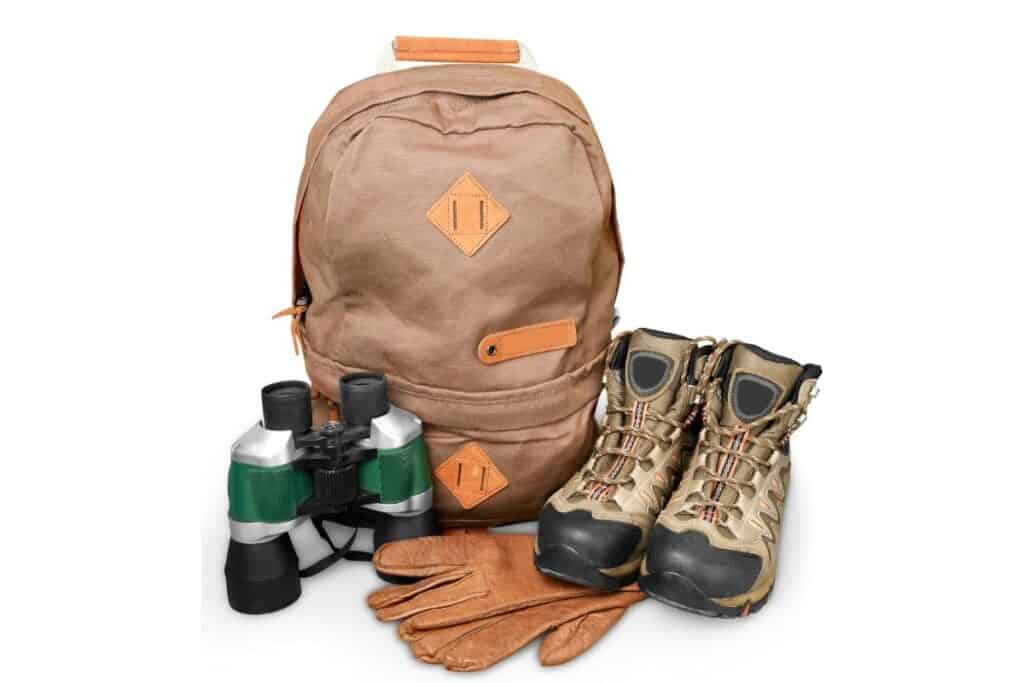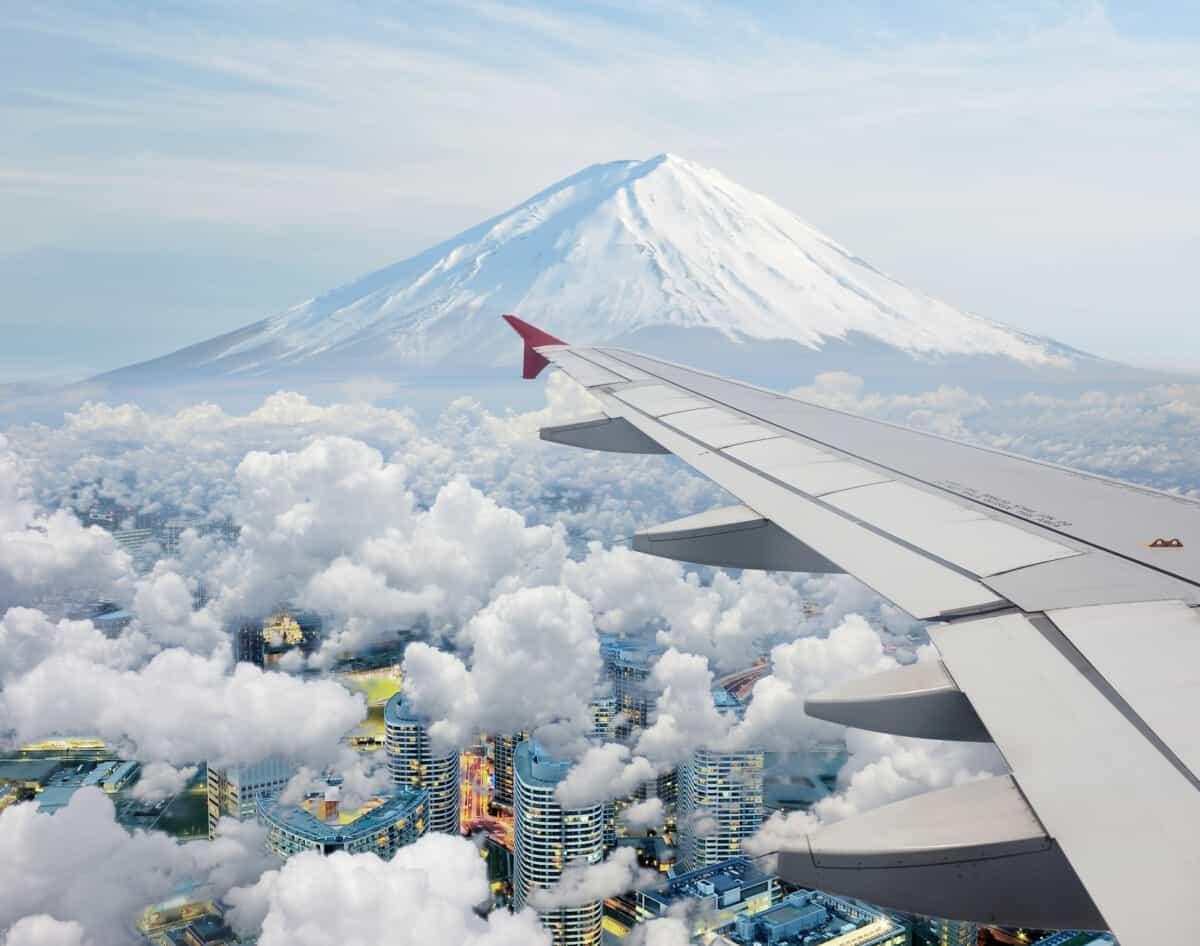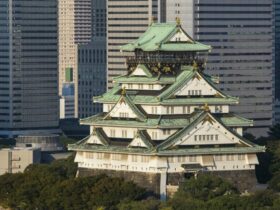My first glimpse albeit very brief was on board a flight from Okinawa back to Tokyo. It was a brief view, shrouded in some clouds obscuring the entire mountain but it was something a knew I had to add to my bucket list.
My next view of Fujisan was during a tour bus trip taking us to the base of Fuji and what was to be an arduous task.
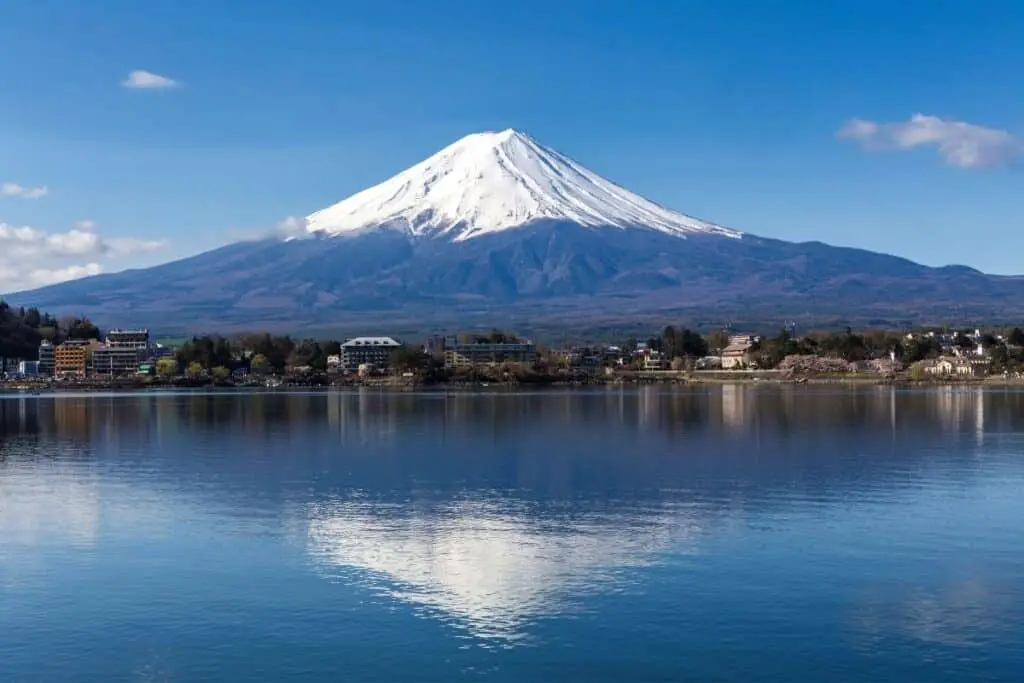
An Introduction
The tip of Fujisan is 12,393 feet above sea level, Mount Fuji is the tallest mountain in Japan and one of the most famous attractions of Japan for tourists and Japanese alike. Every year, the compelling beauty and iconic image of Fujisan attracts huge crowds of tourists. If you plan to know more about the iconic Mount Fuji, I have compiled all that you may be curious about in this article.
Not only is Mount Fuji the highest mountain in all of Japan, but it is also the most climbed and portrayed one. For all citizens of Japan, Fujisan is the pure representation of fortune and good luck. Although it is officially classified as an active volcano, Mount Fuji has a very low risk of eruption.
Now that you have been introduced to Mr. Fuji, one of the most famous symbols of Japan, I understand if you are curious to know a bit more about him. I will discuss all things Fuji and how you can make this adventure too.
What’s The Best Way To Get From Tokyo To Mt Fuji?
The best way of transport to get from Tokyo to Mount Fuji will largely depend on what you plan to do there.
Depending on what you plan to do, the easiest way to get to Mount Fuji from Tokyo are:
1. Tokyo to Mt. Fuji by Bus
Without a doubt, the easiest and cheapest option is by bus. Additionally, you can catch some breathtaking views along the way. From Tokyo station, you just need to catch a direct bus between 6:20 – 9:20 am. Depending on the traffic, the journey may take anywhere between 2 to 2.5 hours.
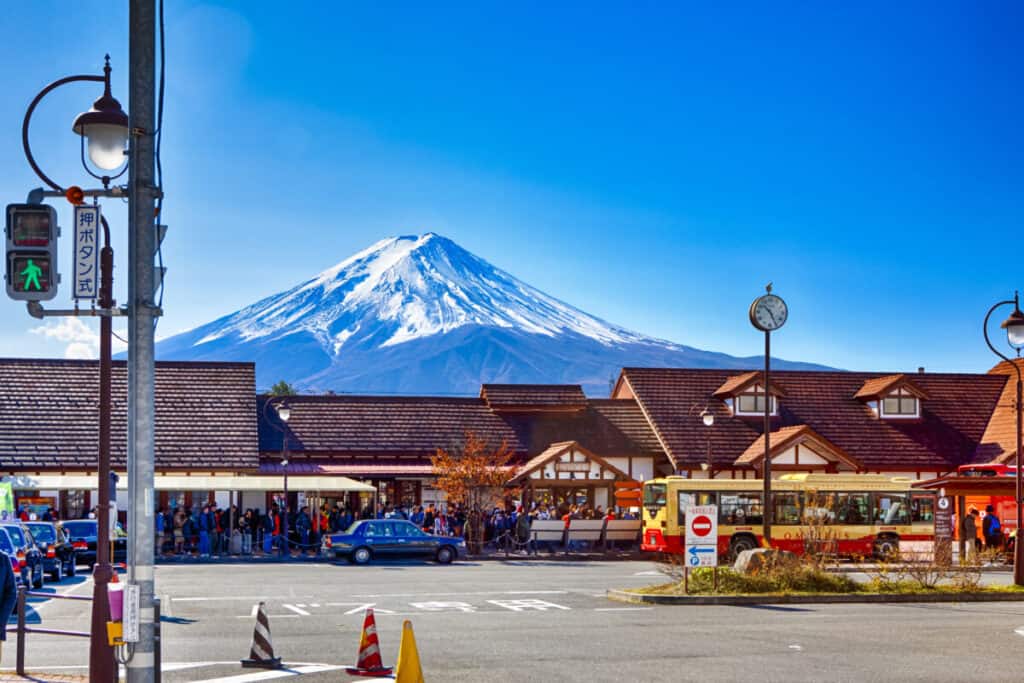
If you plan to visit during the climbing season (July to mid-September), there will be a direct bus from the Shinjuku Expressway Bus terminal to the 5th terminal. Since the buses will fill up quickly during this time, it’s best to reserve seats beforehand.
2. Tokyo to Mt. Fuji by Train
You can catch one of the regular year-round trains that travel from Tokyo to the Mount Fuji area. Although this option is slightly more expensive and takes more time than buses, it will also offer the most aesthetic views of lakes and mountains along the way.
The best option I would recommend is the Fuji Excursion Limited Express Train that starts from the Tokyo Shinjuku Station to the Kawaguchi-ko stop. If you have the JR Pass, you may also get on the Tokaido Shinkansen train to travel from Tokyo to the Odawara station.
As always the Shinkansen is always my first choice as I am a fanatic when it comes to riding the bullet train.
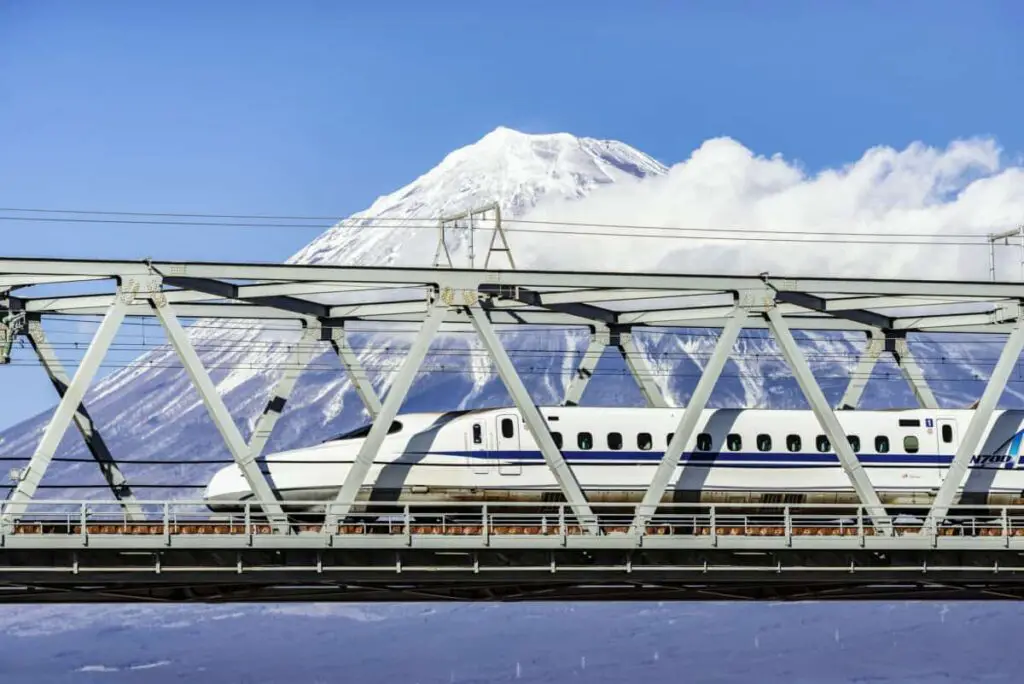
We also opted for the guided tours available to climb Mount Fuji
If you want to enjoy the ultimate Mt. Fuji experience, the guided tours are easily accessible and available. From private tours to group tours, there are many available options to choose from.
You can choose a guided tour that will include some of the best attractions near Mount Fuji as well. Some of the best tours I recommend you check out are:
1. Tokyo to Mount Fuji: Full-Day Tour and Hakone Cruise
2. Mount Fuji Full-Day Scenic Bus Tour from Tokyo
3. Mt. Fuji and Lake Kawaguchi Scenic 1-Day Bus Tour
Climbing Fujisan is no easy feast. But for those with reasonable physical condition, then it can be done with a lot of effort and also a bit of sweat. Be warned it’s not for the fainthearted.
Despite what many may say, Mt. Fuji is not an easy climb. The climb to the top of this mountain is characterized by rapidly changing weather, serious elevation gain, long switchbacks, and steep inclines.
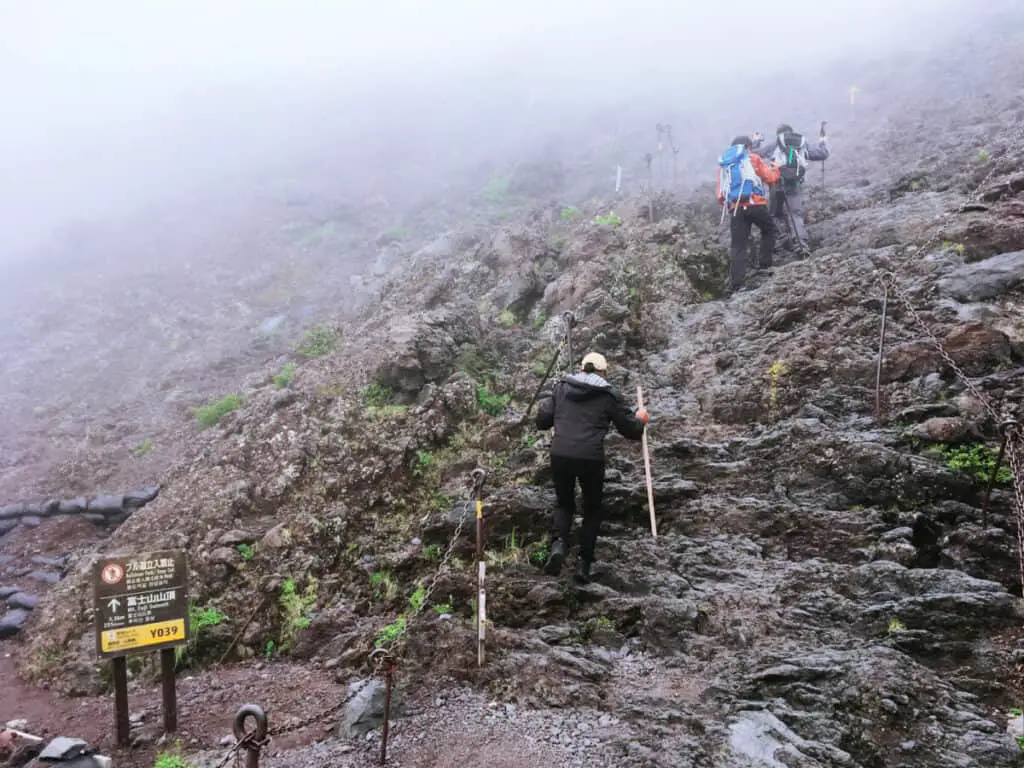
The weather on top of Mount Fuji can never be predicted correctly and unexpected snowstorms, rain downpours, thunderstorms, and other weather patterns are perfectly normal. Without proper physical preparation and conditioning, it is not recommended for anyone to attempt climbing Mt. Fuji.
Private tours to the solo adventure, price wise there is quite a difference.
During the peak season, you are expected to spend at least 100,000 yen for a 2-day private excursion. However, if you plan to join a group tour of around 6 people, the cost drops to as low as 50,000 yen.
During the off-season, (late October to early June) a guided trip is significantly cheaper. The average price for a private guided trip during the weekdays may be about 33,500 yen. You may need to add another 20,000 yen if you have plans to climb Mt. Fuji during the holidays or weekends.
Beginner or Seasoned Climber
As a general rule first-time climbers and those not well-used to mountain climbing, Mount Fuji can be a difficult challenge. For a beginner, preparing all the equipment, routes, and taking necessary precautions might be too difficult and have more significant risks involved in the attempt.
But if you choose to join a ‘Climbing Tour’, even first-timers will have an easy time climbing the ever-challenging Fuji-san. You can find plenty of Mountain Climbing Tours with expert guides arranged by tour companies and travel agencies.
Attempting Fuji in a single day
In total it is very much possible to climb Mount Fuji in a single day. If you are physically fit enough and have proper preparations, climbing the challenging Mt. Fuji is not an impossible feat.
However, do take caution that this is a challenge not everyone can take. I don’t recommend climbing the mountain in a day if you are not in a good shape or get altitude sickness with ease.
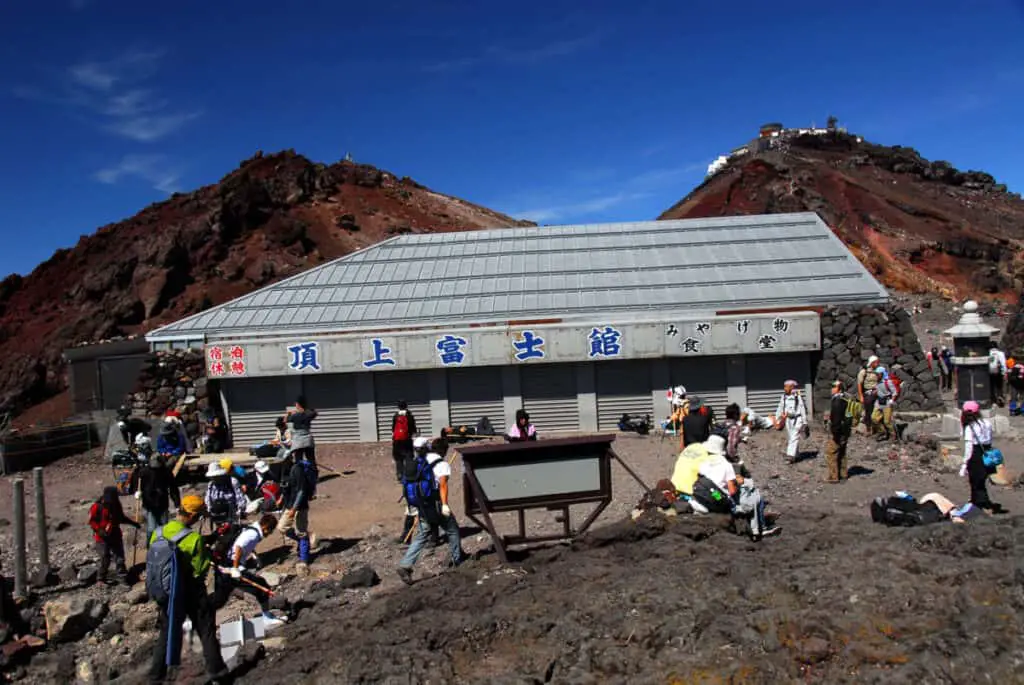
Dangers at Fujisan
It is particularly dangerous to attempt climbing Mount Fuji during the off-season. It is the highest mountain in all of Japan and stands at 12,389 feet/3776 meters above the ground. Weather and trail hazards can be treacherous.
Because of the dangerous snow conditions during the off-season, the public is highly discouraged from attempting to hike the mountain during that time. Despite the dangers involved, it is quite unfortunate that no explicit laws exist in Japan that would prohibit climbers from entering the area and thus there are yearly fatalities.
Best climbing times for Mount Fuji
Without a doubt, the official climbing season is the best time you can climb Mount Fuji. Early July to mid-September is the official climbing season and you will find all the mountain facilities and trails available.
During this period, the weather around the mountain area is relatively mild, the snow melts away, and all the mountain huts are perfectly operating. You can even find easy access to the area by public transportation.
Trials and Trails go hand in hand along your hike. The distance doesn’t seem that far until you take in the elevation.
Yoshida trail to hike up Mount Fuji is 11.6 miles or 18.7 kilometers long. It is a loop trail that starts at the Fuji-Subaru Line 5th Station and then ascends from the Northside of the mountain to the summit in the Yamanashi Prefecture.
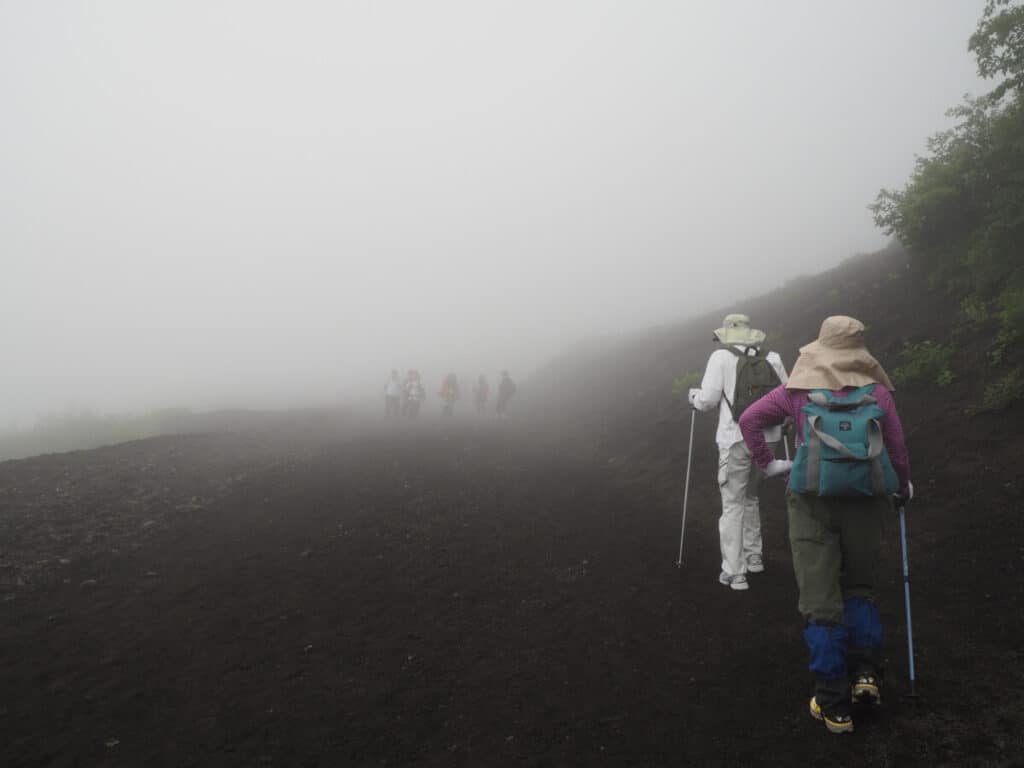
The long trail will offer you a chance to see a few species of wildlife in Japan. Most people will use the Yoshida trail when climbing Mount Fuji. As your altitude increases, vegetation and animals will decrease and a virtual moonscape becomes more common.
Mountain climbing during any time of the year presents obvious hazards and unfortunately, tragedy does happen. Since 1981 over seven million people have climbed fuji.
Every year, a significant number of people die when attempting to climb Mount Fuji. The common causes are due to heart attack or altitude sickness. Many others die from falling rocks or by falling off the trail.
Climbing the mountain is extremely dangerous during the off-season from October to May. Many people cannot handle the severe cold and slide or fall to death on the ice and snow. This is why the public is heavily discouraged from attempting to climb the mountain during this season.
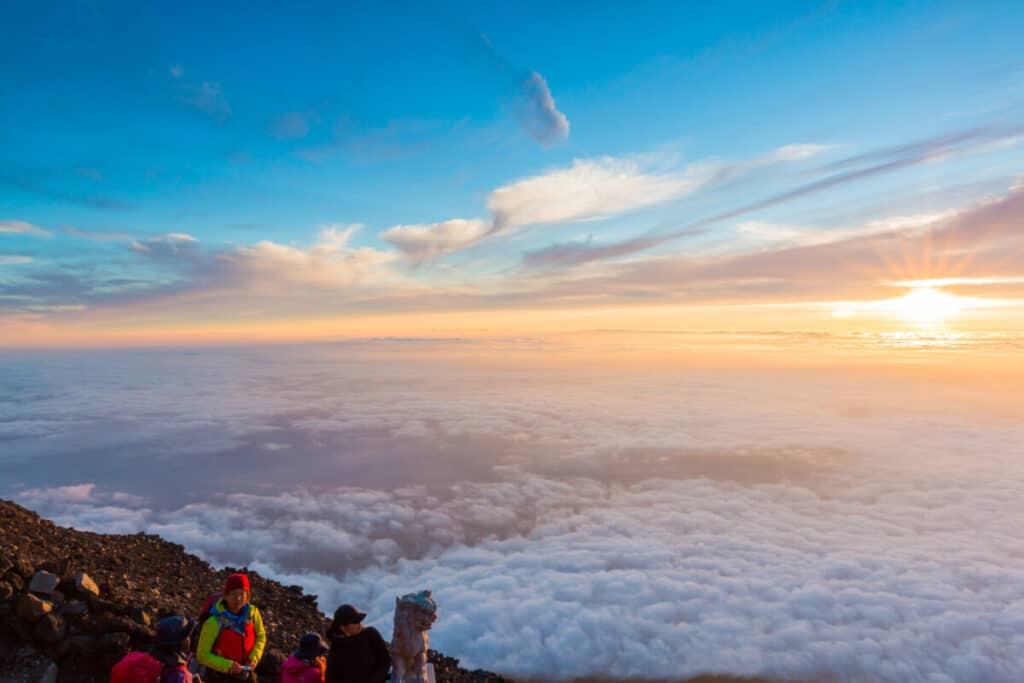
Step By Step Up Mount Fuji
A casual climb up the famous Mount Fuji in Japan will take you about 15,800 steps. It is among the shortest mountain hiking trails in the world, but no less difficult. Some of the longest ones are Bhutan’s Snowman Trek with a whopping 400,000 steps or USA’s Sierra High Route with 390,000 steps.
If you enjoy hiking, the short hiking trip up Mount Fuji is worth it. However, despite being on the shorter side, the hike may prove to be quite challenging and physically exhausting to the unprepared. So, it is always advised to take proper precautions.
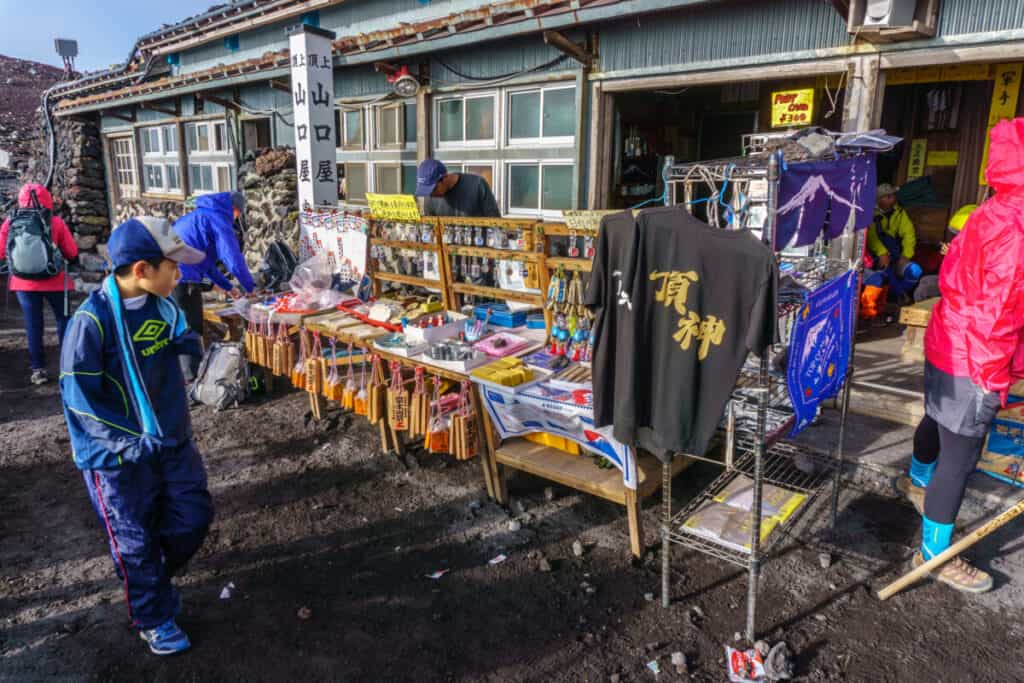
Oxygen to Climb Mount Fuji
Before starting your Climb up Mount Fuji, it is always recommended to pack oxygen. When you get further up the mountain, many people are known to suffer from altitude sickness. You will find significantly thinner air and a lack of oxygen as you near the summit. This can result in severe headaches or dizziness that can prove to be extremely dangerous.
Most people will start their climb at the 5th station and there are stores with snacks, drinks, canisters of oxygen, and other useful equipment and supplies. For safety, make sure to stop by and purchase oxygen. Staff in these supply shops can also assist with information on oxygen usage if needed.
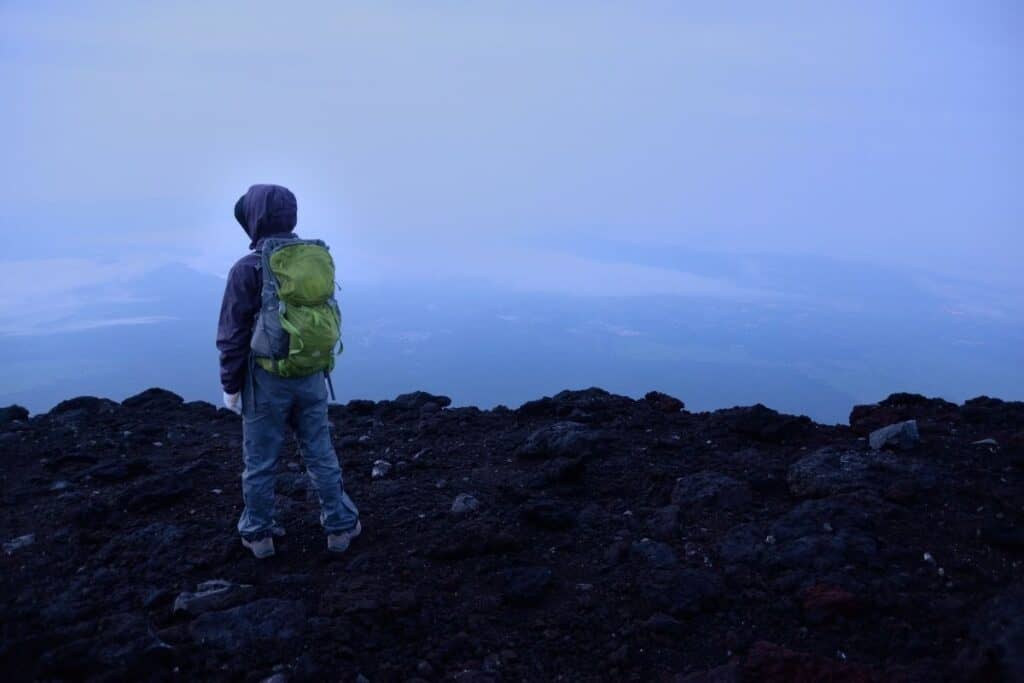
What to Know Before Climbing Mount Fuji?
No doubt, Mount Fuji is the most iconic symbol of Japan, and many tourists dream of climbing to the summit to witness the breathtaking sunrise. For those ready to make this dream come true, let me share some important info you should know before attempting to climb Mount Fuji:
Once a wise man, twice a fool
Japanese proverb
- The best time to climb Mount Fuji is during the Official Hiking Season which happens usually from July to Mid-September.
- As a hiker, you will need to pay an admission fee of 1000 yen. The money goes towards the safety of hikers and protecting the environment of Mount Fuji.
- You can choose among 4 trails to ascend and descend from Mount Fuji.
- To witness the breathtaking sunrise known as goraiko (ご来光) it’s best to start climbing at night.
- If you wish to witness the sunrise, you need to wake up very early in the morning. In the summer, sunrise typically takes place between 4.30-5.00 am.
- You may face altitude sickness when ascending the mountain. The symptoms may include headaches, nausea, dizziness, and trouble breathing. Oxygen canisters are a prudent option.
- To combat altitude sickness, remember to pick up some oxygen from supply locations close to Fuji.
- To use the restrooms on Fuji, you will need to pay. Never forget to keep a handful of coins in your pocket.
- The further you go up the mountain, the colder it will become. So always make sure to wear a few extra layers before climbing.
- In case you face some problems or feel sick on the way to the summit, remember to call these numbers – 119 or 110.
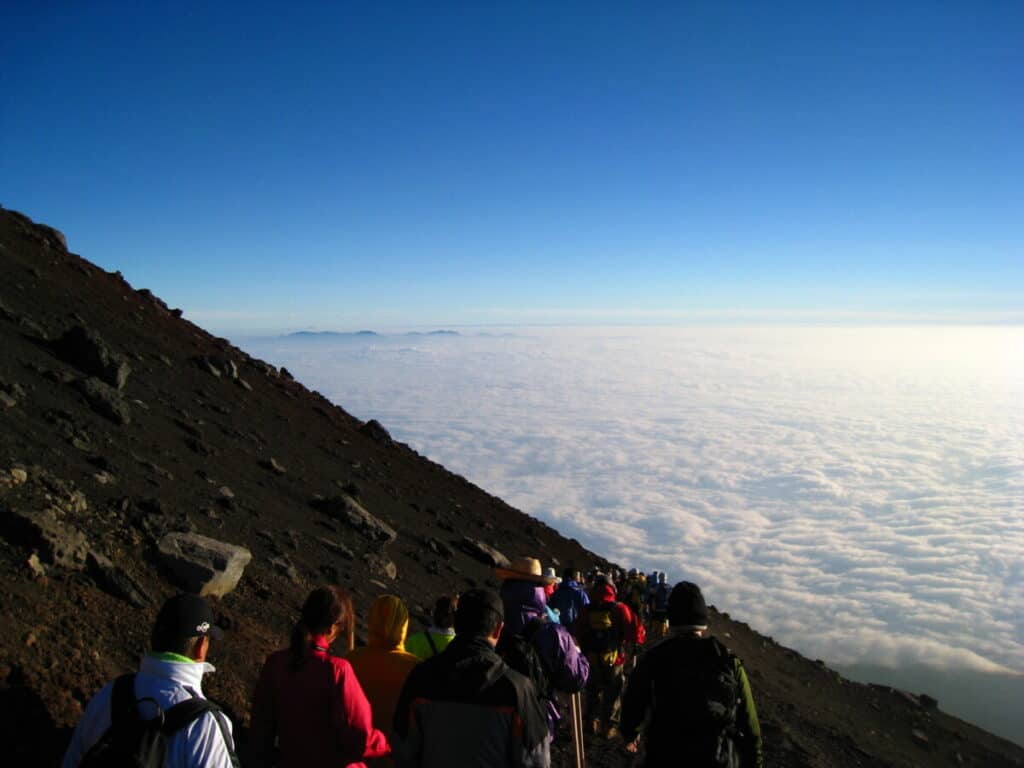
What’s At The Top Of Mount Fuji?
After the hike up Mount Fuji, you will finally get to experience the breathtaking sunrise on the summit. To most climbers, the majestic view is one of the most treasured memories they bring back from their trip to Japan.
You will also find Japan’s highest post office up there. So why not send your loved one’s a postcard from Japan’s highest peak? If you have some extra time you can choose to walk around the summit. But if you like challenges more, make sure to head for the absolute top, Kengamine Peak.
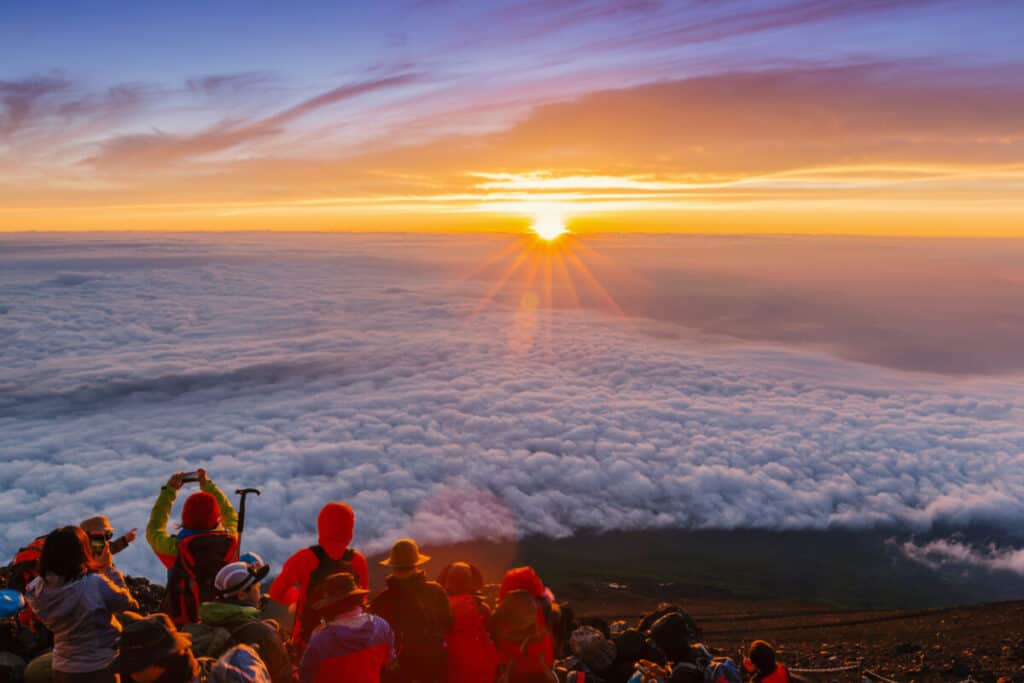
How Many Stations Are on Mt Fuji?
The entirety of Mount Fuji is divided into 10 stations. The first station is at the foot of the mountain and the tenth station is at the summit. Most people start their climb from the 5th station (reachable by bus or auto). The altitude of each station from station five is:
| 7,546 FEET | THE FIFTH STATION (ACCESSIBLE BY BUS OR AUTO) | 2,300 METERS |
| 7,841 FEET | THE SIXTH STATION | 2,390 METERS |
| 8,852 FEET | THE SEVEN STATION | 2,700 METERS |
| 11,155 FEET | THE ORIGINAL EIGHTH STATION | 3,400 METERS |
| 11,318 FEET | THE 8.5 STATION | 3,450 METERS |
| 11,745 FEET | THE NINTH STATION | 3,580 METERS |
| 12,385 FEET | KENGAMINE (HIGHEST POINT) SUMMIT | 3,775 METERS |
Seasons of Fuji and best climbing times
The official climbing season for Mount Fuji is from Early July to Early September. The trails for climbing the mountain will be open to the public only during the summer. All the trails and huts remain closed during any other period other than the climbing season. It is extremely dangerous to climb Mt. Fuji during the snow season.
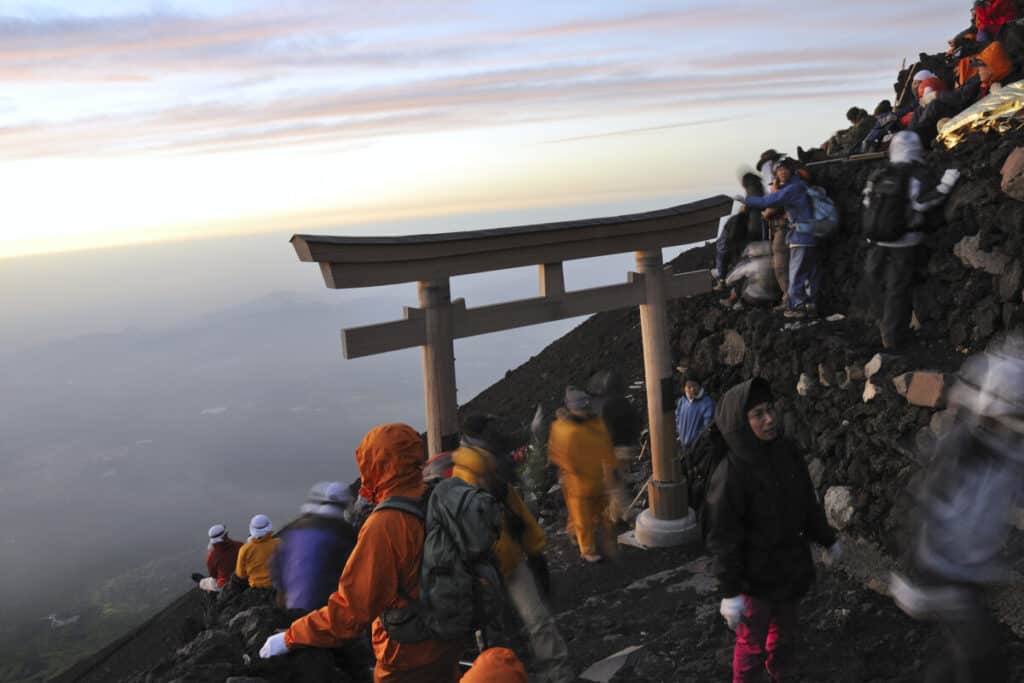
Mount Fuji from Tokyo Prices
Depending on the type of transportation you choose, the cost from Tokyo to Mount Fuji will vary. Let’s take a look at how much different types of transportation may cost you:
- Bus: Around 1,800 yen.
- Local Train: 3,500 yen
- Japan Rail Pass (From Otsuki Station to Kawaguchi-ko Station): 1,140 yen
How Long Does It Take to Climb Mt. Fuji from the Bottom to the Top?
Depending on the trail you choose to climb up Mount Fuji, it may take anywhere between 5 to 10 hours. Most of the climbers will start their hike at the Kawaguchi-ko 5th station. From there, it will take about 5-6 hours on average for someone to climb to the summit.
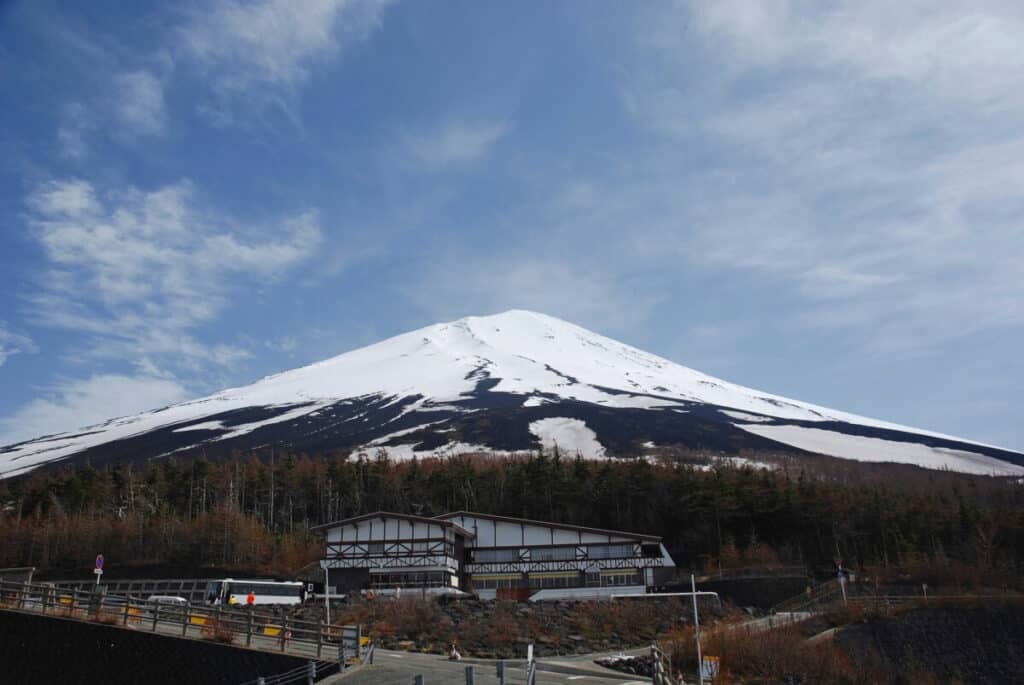
Points of interest around Fujisan
- Fujisan World Heritage Center
- Fuji-Q Highland Amusement Park
- Kawaguchi-ko Station
- Lake Kawaguchiko
- Kitaguchi Hongu Fuji Sengen- jinja Shrine
Do take note that this average time does not take into count any resting break periods in the mountain huts along the trail. Thus, this time does not represent climbing at a relaxed pace to the summit.
It is best to climb at a calm and steady pace and take at least 2 days to reach the summit. If you choose a time when crowds are present then a two-day climb is the best option.
Without a doubt, Mount Fuji is the most iconic symbol of Japan. The next day after our climb I was tired and felt drained of energy. However, the memories will last for many years. I am considering another climb but definitely in the warmer months as we went in the earlier part of summer.
Take extra clothing wear hiking boots carry a walking stick extra hiking foods (energy bars and the like). Bring lots of water and prepare for a view that you will rarely ever see again.
